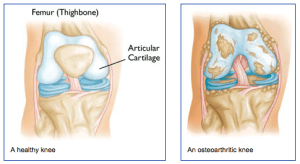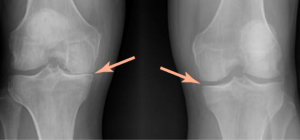 What is arthritis of the knee?
What is arthritis of the knee?
Arthritis of any joint is when there is inflammation and damage to the normal joint surface. The normal articular cartilage is smooth and firm. With arthritis, the surface of the joint becomes pitted, eroded, and irregular causing swelling and pain. There are many types of arthritis.
The most common type of arthritis is osteoarthritis, or wear and tear that is seen in older individuals. Another form of arthritis is rheumatoid arthritis. It is commonly involves multiple joints, especially in the hands and wrists.
It can occur at any age. One more common form of arthritis is post-traumatic arthritis. It follows an injury to the surfaces, the meniscus, or the ligaments, which makes the joint susceptible to arthritis often many years after the injury.
Symptoms
Patients with arthritis typically describe pain and stiffness, especially with the first few steps after getting up from a chair or first thing in the morning. In the early stages of arthritis, the knee is often swollen, and even warm to the touch. After years of having arthritis, the knee rarely swells, but it becomes more difficult to fully straighten or bend the knee. Arthritic knees are painful with activity.
Diagnosis
 The physician’s work-up will start with a careful history and exam. A history of prior injury, pain, stiffness and swelling may suggest arthritis. The exam often shows some swelling and decreased range of motion. Sometimes, patients develop deformities if one side of the knee wears out more than the other side.
The physician’s work-up will start with a careful history and exam. A history of prior injury, pain, stiffness and swelling may suggest arthritis. The exam often shows some swelling and decreased range of motion. Sometimes, patients develop deformities if one side of the knee wears out more than the other side.
The legs can then appear “knock-kneed” or “bow-legged.” X-rays are usually the key in determining the extent of the arthritis. Arthritic knees show loss of normal joint space, cysts and bone spurs on x-ray.
Treatment
Early treatment of arthritis may involve non-steroidal anti-inflammatories, ice, rest, injections and activity modification. If these methods are not satisfactory in keeping a patient from becoming sedentary, surgery is often discussed. Ideally for surgery, patients should be in their mid-60s (current knee replacements last about 20 years or more so are not ideal for those in their 40s or 50s), able to walk only a block or two (considered sedentary), and experience pain at night (effecting quality of life).
However, as techniques and materials become better, physicians are considering knee replacements in younger and younger patients.
Surgical options for arthritis range from arthroscopic debridement (cleaning out the loose pieces and smoothing the surfaces), osteotomies (cutting a wedge out of the bone above or below the knee to try to throw more of the weight onto the better half of the knee), cartilage replacement (transferring plugs of bone and cartilage to the involved areas), to partial or total knee replacements in which the arthritic surfaces are removed and replaced with metal and plastic surfaces.
Your orthopedist will have a thorough discussion with you about which surgical option is best for you, and discuss the risks and benefits of the surgery with you.
